
Concept explainers
(a)
Interpretation:
The given compound is to be identified as
Concept introduction:
Heterocyclic compounds are defined as cyclic compounds which consist of at least one heteroatom, mostly nitrogen, sulfur, or oxygen. Heterocyclic compounds can be aromatic, antiaromatic, or nonaromatic. In some heterocyclic compounds, a noncarbon atom contributes to a p atomic orbital to the aromatic
Huckel’s
1) Aromatic if the number of electrons in that
Answer to Problem 14.20P
The given compound is antiaromatic.
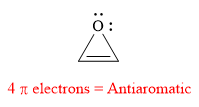
Explanation of Solution
The given compound is:

It is a heterocyclic compound with an oxygen atom. The hybridization of the oxygen atom must be

The total number of electrons in this
The given heterocyclic compound is antiaromatic if the total number of electrons in that
(b)
Interpretation:
The given compound is to be identified as aromatic, antiaromatic, or nonaromatic.
Concept introduction:
Heterocyclic compounds are defined as cyclic compounds which consists of at least one heteroatom mostly nitrogen, sulfur, or oxygen. Heterocyclic compounds can be aromatic, antiaromatic, or nonaromatic. In some heterocyclic compounds, a noncarbon atom contributes a p atomic orbital to the aromatic
Huckel’s rule for aromaticity states that if a species possesses a pi system of molecular orbitals constructed from p-orbitals that are fully conjugated around a ring (
1) Aromatic if the number of electrons in that
Answer to Problem 14.20P
The given compound is aromatic.
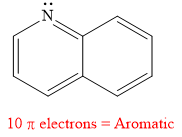
Explanation of Solution
The given compound is:
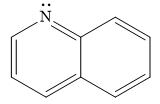
It is a heterocyclic compound with a nitrogen atom. The hybridization of the nitrogen atom must be

Thus, the total number of electrons in this
The given heterocyclic compound is aromatic if the number of electrons in that
(c)
Interpretation:
The given compound is to be identified as aromatic, antiaromatic, or nonaromatic.
Concept introduction:
Heterocyclic compounds are defined as cyclic compounds which consist of at least one heteroatom mostly nitrogen, sulfur, or oxygen. Heterocyclic compounds can be aromatic, antiaromatic, or nonaromatic. In some heterocyclic compounds, a noncarbon atom contributes a p atomic orbital to the aromatic
Huckel’s rule for aromaticity states that if a species possesses a pi system of molecular orbitals constructed from p-orbitals that are fully conjugated around a ring (
1) Aromatic if the number of electrons in that
Answer to Problem 14.20P
The given compound is nonaromatic.
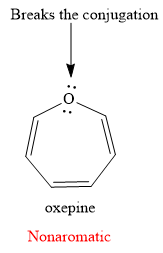
Explanation of Solution
The given compound is:
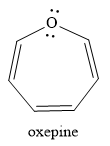
It is an oxygen containing a heterocycle consisting of a seven-membered ring with three double bonds. Due to geometrical constrains, the lone pairs of electrons on the oxygen atom are not in conjugation with the

If the molecule is assumed to be planar (flat), then too it would contain
The rule for aromaticity or antiaromaticity applies only if the system is planar, cyclic and has overlap of p-orbitals.
(d)
Interpretation:
The given compound is to be identified as aromatic, antiaromatic, or nonaromatic.
Concept introduction:
Heterocyclic compounds are defined as cyclic compounds which consists of at least one heteroatom mostly nitrogen, sulfur, or oxygen. Heterocyclic compounds can be aromatic, antiaromatic, or nonaromatic. In some heterocyclic compounds, a noncarbon atom contributes a p atomic orbital to the aromatic
Huckel’s rule for aromaticity states that if a species possesses a pi system of molecular orbitals constructed from p-orbitals that are fully conjugated around a ring (
1) Aromatic if the number of electrons in that
Answer to Problem 14.20P
The given compound is nonaromatic.
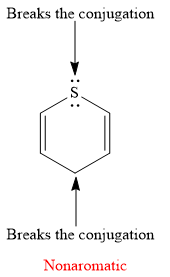
Explanation of Solution
The given compound is:

It is a sulfur containing a heterocycle consisting of a six-membered ring with two double bonds. There are two lone pair of electrons on the sulfur atom, but the sulfur atom is

As the
The rule for aromaticity or antiaromaticity applies only if the system is planar, cyclic and has overlap of p-orbitals.
(e)
Interpretation:
The given compound is to be identified as aromatic, antiaromatic, or nonaromatic.
Concept introduction:
Heterocyclic compounds are defined as cyclic compounds which consists of at least one heteroatom mostly nitrogen, sulfur, or oxygen. Heterocyclic compounds can be aromatic, antiaromatic, or nonaromatic. In some heterocyclic compounds, a noncarbon atom contributes a p atomic orbital to the aromatic
Huckel’s rule for aromaticity states that if a species possesses a pi system of molecular orbitals constructed from p-orbitals that are fully conjugated around a ring (
1) Aromatic if the number of electrons in that
Answer to Problem 14.20P
The given compound is nonaromatic.
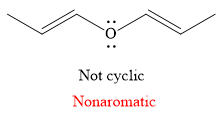
Explanation of Solution
The given compound is:

It is a straight chain compound with an oxygen atom and two double bonds. The above compound is not a cyclic compound. The rule for aromaticity or antiaromaticity applies only if the system is planar, cyclic and has overlap of p-orbitals. Thus, the

The rule for aromaticity or antiaromaticity applies only if the system is planar, cyclic and has overlap of p-orbitals.
(f)
Interpretation:
The given compound is to be identified as aromatic, antiaromatic, or nonaromatic.
Concept introduction:
Heterocyclic compounds are defined as cyclic compounds which consists of at least one heteroatom mostly nitrogen, sulfur, or oxygen. Heterocyclic compounds can be aromatic, antiaromatic, or nonaromatic. In some heterocyclic compounds, a noncarbon atom contributes a p atomic orbital to the aromatic
Huckel’s rule for aromaticity states that if a species possesses a pi system of molecular orbitals constructed from p-orbitals that are fully conjugated around a ring (
1) Aromatic if the number of electrons in that
Answer to Problem 14.20P
The given compound is aromatic.
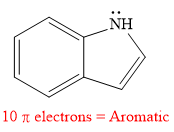
Explanation of Solution
The given compound is:

It is a heterocyclic compound with a nitrogen atom in which one six-membered and one five-membered rings are fused. The hybridization of the nitrogen atom is

Thus, the total number of electrons in this
The given heterocyclic compound is aromatic if the number of electrons in that
Want to see more full solutions like this?
Chapter 14 Solutions
Organic Chemistry: Principles and Mechanisms (Second Edition)
- Complete the following esterification reaction by drawing the structural formula of the product formed. HOH HO i catalyst catalyst OH HO (product has rum flavor) (product has orange flavor)arrow_forwardThe statements in the tables below are about two different chemical equilibria. The symbols have their usual meaning, for example AG stands for the standard Gibbs free energy of reaction and K stands for the equilibrium constant. In each table, there may be one statement that is faise because it contradicts the other three statements. If you find a false statement, check the box next to t Otherwise, check the "no false statements" box under the table. statement false? AG"1 no false statements: statement false? AG-0 0 InK-0 0 K-1 0 AH-TAS no false statements 2arrow_forwardComplete the following esterification reactions by drawing the line formulas of the carboxylic acid and alcohol required to form the ester shown. catalyst catalyst catalyst apricot fragrancearrow_forward
- Show the saponification products of the following ester: You don't need to draw in the Na+ cation. catalyst, A catalyst, A catalyst, Aarrow_forwardWhat would happen if the carboxylic acid and alcohol groups were on the same molecule? In essence, the molecule reacts with itself. Draw the structure of the products formed in this manner using the reactants below. If two functional groups interact with one another on the same molecule, this is called an “intramolecular" (within one) rather than "intermolecular" (between two or more) attack. OH OH catalyst OH HO catalyst catalyst HO OHarrow_forwardQ3: Write in the starting alkyl bromide used to form the following products. Include any reactants, reagents, and solvents over the reaction arrow. If more than one step is required, denote separate steps by using 1), 2), 3), etc. H OH racemic OH OH 5 racemicarrow_forward
- Draw the Lewis structure of the SO3-O(CH3)2 complex shown in the bottom right of slide 2in lecture 3-3 (“Me” means a CH3 group) – include all valence electron pairs and formal charges.From this structure, should the complex be a stable molecule? Explain.arrow_forwardPredict all organic product(s), including stereoisomers when applicable.arrow_forwardQ5: Propose a reasonable synthesis for the following decalin derivative. using only decalin and alkanes of 3 or fewer carbons. Decalin H3C HO க CH3arrow_forward
- 2Helparrow_forwardplease add appropriate arrows, and tell me clearly where to add arrows, or draw itarrow_forwardWhat I Have Learned Directions: Given the following reaction and the stress applied in each reaction, answer the question below. A. H2(g) + Cl2(g) 2 HCl(g) Stress applied: Decreasing the pressure 1. What is the Keq expression? 2. What will be the effect in the number of moles of HCl(g)? 3. What will be the Equilibrium Shift or the reaction? B. Fe3O4(s) + 4 H2(g) + heat 53 Fe(s) + 4 H₂O(g) Stress applied: Increasing the temperature 1. What is the Keq expression?. 2. What will be the effect in the volume of water vapor collected? 3. What will be the Equilibrium Shift or the reaction? C. 4 NH3(g) + 5 O2(g) 4 NO(g) + 6 H2O(g) + heat Stress applied: Increasing the volume of the container 1. What is the Keq expression?. 2. What will be the effect in the amount of H₂O? 3. What will be the Equilibrium Shift or the reaction?arrow_forward
 Organic Chemistry: A Guided InquiryChemistryISBN:9780618974122Author:Andrei StraumanisPublisher:Cengage Learning
Organic Chemistry: A Guided InquiryChemistryISBN:9780618974122Author:Andrei StraumanisPublisher:Cengage Learning
